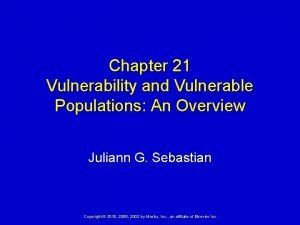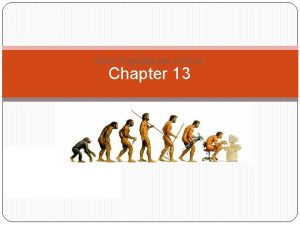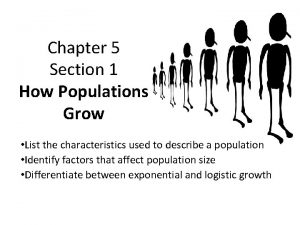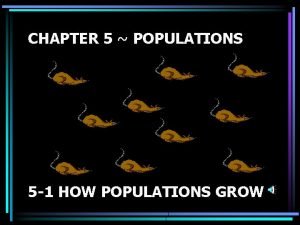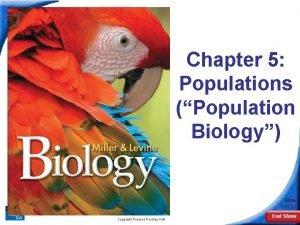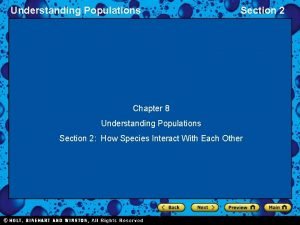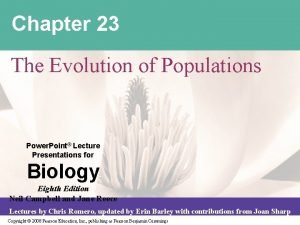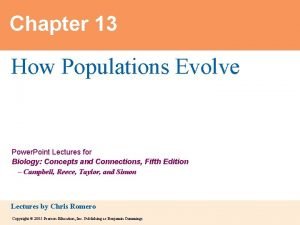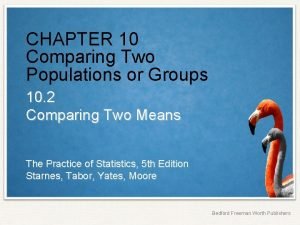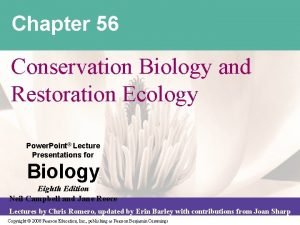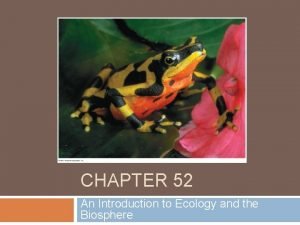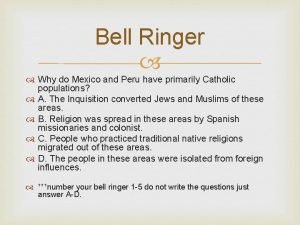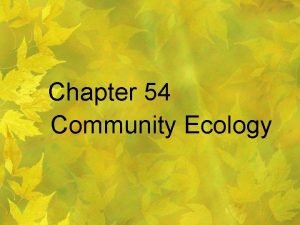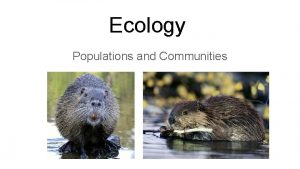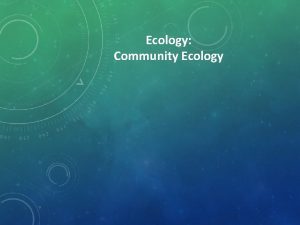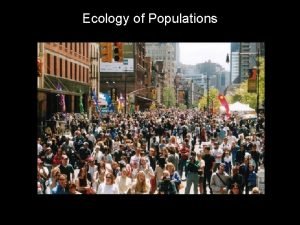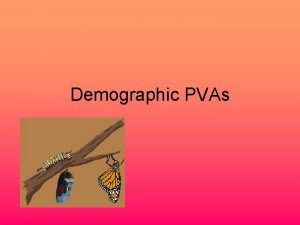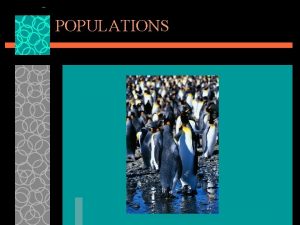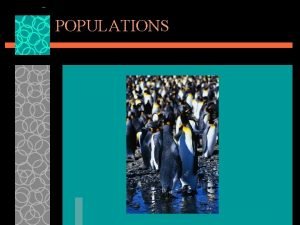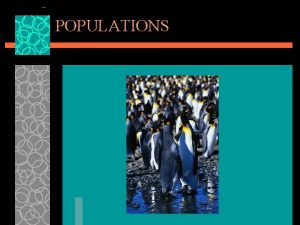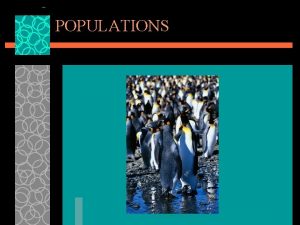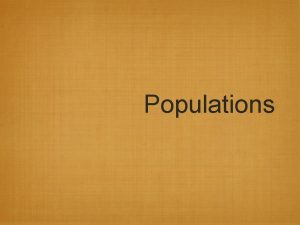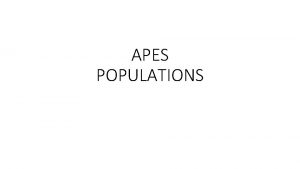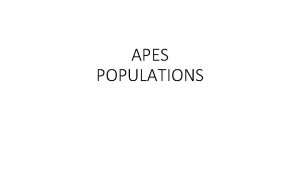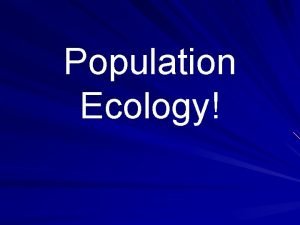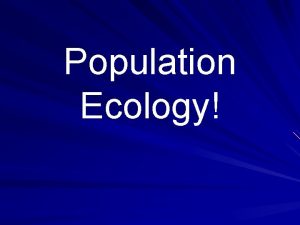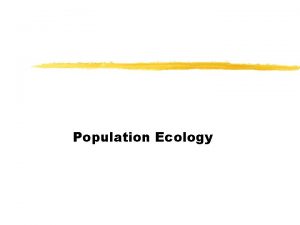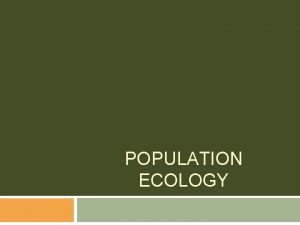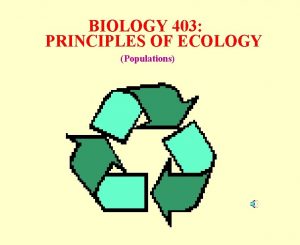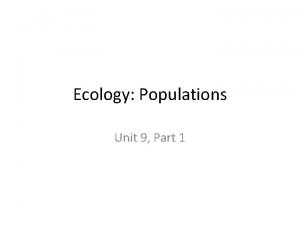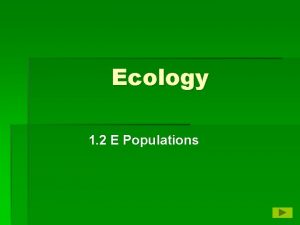Ecology of Individuals and Populations Chapter 56 1


































- Slides: 34

Ecology of Individuals and Populations Chapter 56 1

Environmental Challenge • Ecology – Study of how organisms relate to one another and to their environments • Key elements of the environment – Temperature – Water – Sunlight – Soil 2

Environmental Challenge • Homeostasis – Individual must maintain a steady-state internal environment regardless of external environment • Beetle is catching water to help live in a dry environment • Some are “conformers” – adopt temperature, salinity of their surroundings 3

Environmental Challenge • Reponses can be short or long term • Short term – From a few minutes, to an individual’s lifetime – Variety of ways to cope • Long term – Natural selection can operate to make a population better adapted to the environment 4

Population Demography • Demography – Quantitative study of populations – How size changes through time • Whole population: increasing, decreasing, remaining constant • Population broken down into parts –Study birth and death rates of a specific age 5

Demography and Dynamics • Population growth can be influenced by the population’s sex ratio – Number of births directly related to number of females • Generation times: average interval between birth of an individual and birth of its offspring – Populations with short generations can increase in size more quickly than populations with long generations 6

• In general, larger organisms have longer generation times, although there are exceptions 7

Population Demography • Age structure – Determined by the numbers of individuals in a different age group – Cohort: group of individuals of the same age – Fecundity: number of offspring produced in a standard time – Mortality: death rate in a standard time • Age structure has a critical influence on a population’s growth rate 8

Life tables show probability of survival and reproduction through a cohort’s life 9

Population Demography • Survivorship – Percent of an original population that survives to a given age • Survivorship curve – Express some aspects of age distribution 10

Life History • Natural selection favors traits that maximize the number of surviving offspring left in the next generation by an individual organism – 2 factors affect this quantity • How long an individual lives • How many young it produces each year 11

• Life history – Complete life cycle of an organism • Trade-off: limited resources vs increased reproduction 12

Environmental Limits to Population Growth • Populations often remain the same size regardless of the number of offspring born • Exponential growth model applies to populations with no growth limits r = (b – d) + (i – e) • r = rate of population increase; b = birth rate; d = death rate; i = immigration; e = emigration 13

Environmental Limits to Population Growth • Biotic potential: e = i, and there are no limits on population growth, then: d. N = ri. N dt • N is the number of individuals in the population; d. N/dt is the rate of change over time; ri is the intrinsic rate of natural increase for the population = innate capacity for growth 14

Environmental Limits to Population Growth • The biotic potential of any population is exponential, even when the rate of increase remains constant – Result of unchecked exponential growth is a population explosion • All populations eventually reach some limit imposed by a shortage • Carrying capacity: symbolized by K, is the maximum number of individuals that the environment can support 15

Environmental Limits to Population Growth • Logistic growth model: applies to populations as they reach K d. N/dt = r. N (K – N)/K – d. N/dt is equal to intrinsic rate of natural increase, adjusted for the amount of available resources • If you plot N versus t, you obtain a sigmoidal growth curve 16

Red line illustrates the exponential growth model; blue line illustrates the logistic growth model 17

• As N approaches K, the rate of population growth begins to slow • If N = K the population growth rate is zero – If the population size exceeds K, the population size will decline until it reaches K 18

Many populations exhibit logistic growth 19

Factors That Regulate Populations • Density-dependent – Factors that affect the population and depend on population size • Density-independent – Other factors, such as natural disasters, affect populations regardless of size 20

Factors That Regulate Populations Density-dependent effects Negative feedback 21

Density dependence in the song sparrow on Mandarte island 22

Factors That Regulate Populations At high populations, locusts have different hormonal and physical characteristics and take off as a swarm Positive feedback: Allee effect Growth rates increase with population size 23

Factors That Regulate Populations • Density-independent effects – Rate of growth of a population at any instant is limited by something unrelated to the size of the population – External environment aspects: cold winters, droughts, storms, volcanic eruptions – Populations display erratic growth patterns because of these events 24

Population cycles may reflect complex interactions with the environment Fluctuations in the number of pupae of four moth species in Germany Same factor regulating population size of different species 25

Factors That Regulate Populations • North American snowshoe hare has a 10 -year cycle • Population numbers fall 10 -fold to 30 fold in a cycle, and 100 -fold changes can occur • Two factors generate this cycle: – Food plants – Predators 26

Factors That Regulate Populations • Resource availability affects life history adaptations • When resources are limited, the cost of reproduction is high – Selection will favor individuals that can compete and utilize resources efficiently – Can lower reproductive rates – K-selected populations: adapted to thrive when population is near its 27 carrying capacity

Factors That Regulate Populations • Populations far below carrying capacity, resources abundant – Costs of reproduction are low – r-selected populations: selection favors individuals with the highest reproductive rates • Most natural populations show life history adaptations that exist along a continuum of r- and K-selected traits 28

29

Human Population Growth • K-selected life history traits – Small brood size – Late reproduction – High degree of parental care • Changes since the 1700 s allowed humans to escape logistic growth • Human populations have grown exponentially – Birth rate has remained unchanged – Death rate has fallen dramatically 30

Human Population Growth History of human population size 31

Human Population Growth • Earth’s rapidly growing human population constitutes perhaps the greatest challenge to the future of the biosphere • Uneven distribution among countries • Increasing gap between rich and poor • The world ecosystem is already under stress • What is K for the human population? • Thomas Malthus: Essay on the Principle of Population 32

Human Population Growth Distribution of population growth 33

Human Population Growth Ecological Footprint: amount of productive land required to support an individual at the standard of living of a particular population through the course of his/her life 34
 Gene pool
Gene pool Chapter 21 vulnerability and vulnerable populations
Chapter 21 vulnerability and vulnerable populations Chapter test a chapter 4 population ecology answer key
Chapter test a chapter 4 population ecology answer key Chapter 16 evolution of populations vocabulary review
Chapter 16 evolution of populations vocabulary review Chapter 13 how populations evolve test
Chapter 13 how populations evolve test Chapter 17 evolution of populations answer key
Chapter 17 evolution of populations answer key Chapter 5 lesson 1 how populations grow answer key
Chapter 5 lesson 1 how populations grow answer key Chapter 5 lesson 1 how populations grow
Chapter 5 lesson 1 how populations grow Chapter 23 the evolution of populations
Chapter 23 the evolution of populations Section 16-1 genes and variation
Section 16-1 genes and variation Chapter 10 comparing two populations or groups answer key
Chapter 10 comparing two populations or groups answer key Section 5-1 how populations grow
Section 5-1 how populations grow Chapter 8 understanding populations
Chapter 8 understanding populations Chapter 23 the evolution of populations
Chapter 23 the evolution of populations Chapter 13 how populations evolve
Chapter 13 how populations evolve Chapter 10 comparing two populations or groups
Chapter 10 comparing two populations or groups Chapter 52 an introduction to ecology and the biosphere
Chapter 52 an introduction to ecology and the biosphere Chapter 56 conservation biology and restoration ecology
Chapter 56 conservation biology and restoration ecology Phosphorus cycle pearson education
Phosphorus cycle pearson education Chaparral climograph
Chaparral climograph Organism
Organism Chapter 55 ecosystems and restoration ecology
Chapter 55 ecosystems and restoration ecology Chapter 5 evolution and community ecology
Chapter 5 evolution and community ecology Ecosystems interactions
Ecosystems interactions Stabilizing selection human birth weight
Stabilizing selection human birth weight Evolution of populations section 16-1 genes and variation
Evolution of populations section 16-1 genes and variation Why do mexico and peru have primarily catholic populations
Why do mexico and peru have primarily catholic populations Chapter 3 section 1 community ecology
Chapter 3 section 1 community ecology Chapter 54 community ecology
Chapter 54 community ecology Chapter 53 population ecology
Chapter 53 population ecology Equilibrial life history
Equilibrial life history Principles of ecology chapter 2 section 1 answer key
Principles of ecology chapter 2 section 1 answer key Chapter 2 principles of ecology answers
Chapter 2 principles of ecology answers Principles of ecology chapter 2 section 1 answer key
Principles of ecology chapter 2 section 1 answer key Ecology
Ecology

